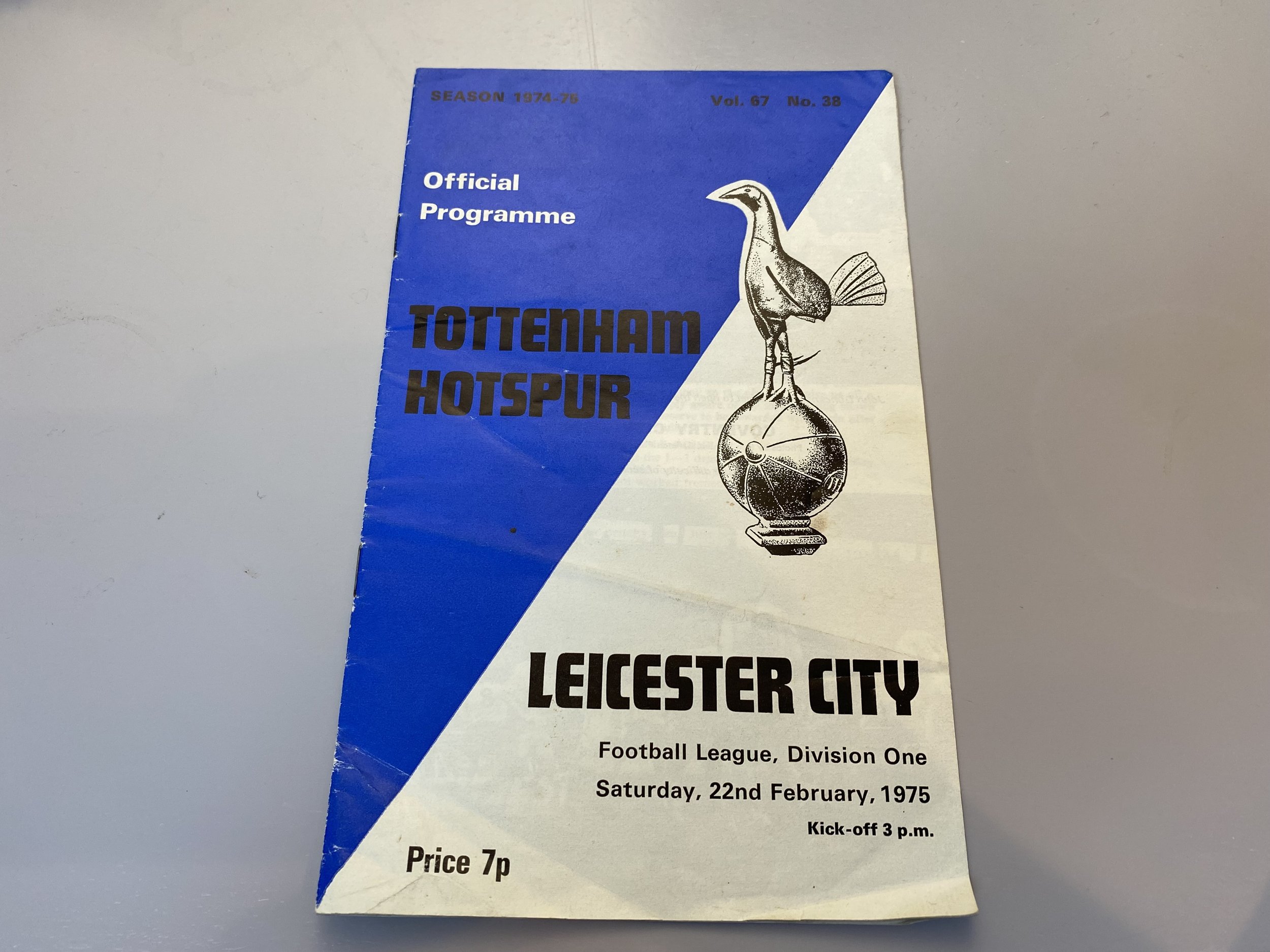The postman, the programme and the four-pointer: When Leicester City won at Tottenham Hotspur
In 1975, Leicester City were in a relegation battle along with Arsenal, Chelsea and Tottenham Hotspur. The Foxes were at the foot of the First Division when they made the trip to White Hart Lane.
In the past few months, the postman has been delivering me little packages from the past. I’ve ordered programmes from Leicester wins at Brentford in 1952, Ipswich in 1962, Newcastle in 1985.
He hands over our post, we have a little chat as always and he continues on his way, smiling and talking to everyone else on the street.
Now we reach Tottenham in 1975. I take the envelope from him, eagerly open it and start flicking through…
It’s immediately clear that all was not well at White Hart Lane in February 1975 ahead of the visit of bottom-of-the-table Leicester City. On the opening page, there’s a welcome titled ‘League Plight’:
“After successive away engagements in the midlands, we make another effort this afternoon to improve our poor home record.
We welcome our good friends from Leicester this afternoon, and despite the strain of their mid-week fifth-round FA Cup replay with Arsenal, played after this programme went to press, we know we will be facing a determined team.”
That replay at Highbury, which had taken place the previous Wednesday, also ended in a draw. This meant a second replay was scheduled for the Monday night back at Filbert Street, two days after the league game at White Hart Lane.
These were the days before relegation six-pointers. In the morning’s Daily Mirror, Tottenham captain Martin Peters of 1966 World Cup final fame - speaking somewhat like his words had been paraphrased by a tabloid journalist - said:
“This is the match that could mean so much to all of us at Tottenham. If we win, it could be the start of our survival in the First Division.
If we don’t, it may signpost the start of our slide into the Second. At this stage of the season it’s an obvious four-point battle.”
“The trouble is we have this problem about playing at home. We can’t break teams down. It’s easier playing away simply because we can contain teams better.
I’ve quite enjoyed the last two matches. But they were away. It’s difficult at our place.”
Tottenham were struggling at home but Leicester were struggling everywhere, taking just four points from 14 games between 9th November and 8th February. Those four points consisted of two draws with Chelsea, yet another draw against Arsenal and a 1-1 draw at home to Stoke.
First choice goalkeeper Mark Wallington was unavailable for half of those games after breaking a bone in his hand. This was particularly untimely given Peter Shilton had just been sold to Stoke.
Wallington took his place between the sticks for the trip to White Hart Lane though, and Leicester manager Jimmy Bloomfield was bullish, stating: “If we play as well as we did against Arsenal in this week’s cup tie, we should get through against Spurs and reach eventual safety.”
Leicester fans growing up in the bleak early years of the 1990s heard endless tales of how Bloomfield’s side was an entertainment roadshow rolling around the country and dazzling opposition fans with their skill.
Despite the mudbath of a pitch at White Hart Lane and the scruffy nature of the goals Leicester scored that day, there are clear indicators of style.
Just not in the opening goal, Frank Worthington’s miskick falling to Mike Stringfellow to poke the ball in from close range.
The second goal after the break was slightly less scrappy, Bob Lee squaring the ball to Worthington to fire past Jennings.
And although the third was another close range prod, the build-up was sensational with Worthington playing a magnificent long ball from one side to the other. He found Keith Weller, who danced past his marker to lay the ball on for Lee six yards from goal. Lee’s shot was palmed out for Jon Sammels to score.
The Daily Mirror reporter backed Bloomfield’s Leicester against accusations of aggressive tactics from Tottenham manager Terry Neill:
“Tottenham went through Saturday’s match looking just like a side booked for the drop. ‘For a team that’s rated as one of the most attractive in the country, Leicester did some brutal things’, Neill complained.
“Yet Leicester seemed merely to be showing the determination and fight which Tottenham lacked. Ball-juggling Alfie Conn apart, virtually all the football came from Leicester, now only four points behind Tottenham with three games in hand.
“Frank Worthington completely overshadowed Martin Chivers. Martin Peters was ghost-like alongside hard-working Jon Sammels, and Mike England looked his age when watching Leicester new boy Jeff Blockley inspire his defence. Once again, only the brilliant goalkeeping of Pat Jennings prevented a more disastrous score.
“The fans chanted for Neill’s head and the return of Bill Nicholson, who resigned in September. No wonder a player going on the Belgrade trip said: ‘The best place for us at the moment is out of the country.’”
The day after Leicester’s FA Cup replay against Arsenal at Filbert Street - a 1-0 defeat - Tottenham flew out to Yugoslavia to play Red Star Belgrade in a friendly, which they won 1-0. The only goal was scored by Chris Jones, who had been part of Spurs’ 1974 FA Youth Cup-winning team alongside the likes of Neil McNab, who would make 72 league appearances for the club.
The Belgrade jaunt didn’t do any immediate good for Tottenham, who lost their next three league games. But the last of those three - a 2-0 home defeat to Liverpool - was the last time they lost at White Hart Lane that season. Four home wins in a row helped secure First Division safety and they stayed up alongside Arsenal and Leicester, while Chelsea were relegated to Division Two.
In the summer of 1975, the lads that had won the FA Youth Cup for Tottenham the previous summer went their separate ways. Some, like Jones and McNab, stayed on and played for the first team. But most were released.
This is where we pick up the story of John Margerrison, a strong midfielder with a good passing range. On the same day Leicester won 3-0 at White Hart Lane, he was playing for Tottenham Reserves at Filbert Street.
Margerrison scored Tottenham’s goal in the first leg of the FA Youth Cup final against Huddersfield. He had played alongside Glenn Hoddle and Graeme Souness in the Spurs youth system, but he was allowed to depart on a free transfer in 1975.
Fulham signed Margerrison and he briefly played alongside George Best and Rodney Marsh at Craven Cottage. His career highlight came in Fulham white, scoring against Manchester United in the FA Cup. In 1979, he joined Leyton Orient, then played for Kansas City Comets in indoor football in the United States followed by a return to the UK to play for Wealdstone.
In the summer of 1983, Barry Fry called him out of the blue and asked him to sign for Barnet. He made around 200 appearances for the Bees and is fondly remembered by Barnet fans, who used to implore his team-mates to “spread it to Marge”.
Now in his mid-70s, John Margerrison works as a postman, chatting away to people as he hands over the old football programmes they’ve ordered over the internet and smiling at everyone he meets.




